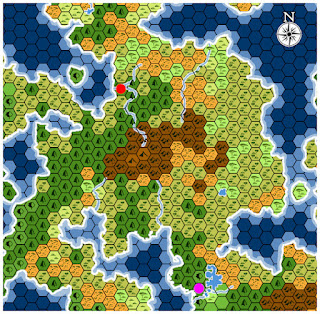Now that we have most of our natural features established on our map and we’ve taken stock of the scale and overall size of the campaign area, we need to add some settlements. Dwarf Fortress is no longer any help to us, as the starting map it generated didn’t contain any cities or settlements. Note that the program could have generated a whole civilization for us, complete with history and such. However, the result wouldn’t have been very useful for our needs. Anything produced by Dwarf Fortress ends up being pretty specific to the nuances of that game and its setting.
It would be helpful to have some kind of guidance going forward, however. For that help, I’m turning to the first of our specific tabletop-related resources: An Echo Resounding, by Kevin Crawford. While partially a book on domain management and mass combat written for Labyrinth Lord, Echo also contains great guidance on building a D&D-style campaign using a sort of top-down approach, which is what we're interested in. I’m going to be following its advice through this step and possibly beyond.
Step 9: Placing Cities
To quote Crawford (2012) “Not every village and tribal campsite needs to be qualified as a location…At this stage, you are concerned only with the major City and market Town locations of your region” (p. 10). Crawford (2012) recommends placing a City “along rivers, or along seacoasts where a river empties into the ocean” (p. 10).
I’m not going to directly quote Echo any further, but here’s a summary of the advice it offers:
- A relatively unsettled region (which is good for D&D gaming) should only have about 1 proper “city”.
- Cities need a lot of surrounding farmland to support them (and about 10x as many farmer-peasants as city dwellers).
- Cities usually develop near water.
- A city on the edge of civilization should have a population of about 10,000 – 15,000.
- Cities should be far away from one another.
Looking at my map, I decided to bend the rules above a bit and place 2 cities. The map we have is divided into north and south regions by those mountains near the center. I think a mountain range forms a nice border and gives justification for perhaps two separate cultures existing here: one to the north, one to the south.
Remember, too, that our campaign map is a cropped version of a much larger map. There is plenty of land north and south of where we’ve arbitrarily decided to zoom in for our project. Perhaps our map represents the relatively unsettled borderland between two more developed nations who are slowly encroaching upon this unsettled wilderland.
With that in mind, I added two dots to represent two large cities, a red dot to the north and a purple dot to the south.
Purple Dot: Probably a better location than the northern city, this location is on a river, along a coast, near a large lake, and surrounded by forest and adjacent to grasslands. There are some badlands to the northeast, but the region here seems pretty hospitable.
Step 10: Placing Towns
Crawford recommends placing four towns per city on the map, spread out fairly evenly along coasts, rivers, or in any particularly blank spots on the map. I’ve done that here, keeping to the color schemes of red toward the north and purple in the south. At this point, those colors denote some kind of cultural connection or affiliation, but I’m not yet sure what.
And here’s a version where I’ve replaced the bright dots with more appropriate map symbols. Large black dots ringed in white for cities. Smaller white dots ringed in black for towns.
Up Next
We'll add potential adventure sites to our map.







No comments:
Post a Comment